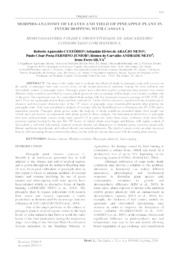Morpho-anatomy of leaves and yield of pineapple plant in intercropping with cassava.
Morpho-anatomy of leaves and yield of pineapple plant in intercropping with cassava.
Resumo: The aims of this study were to evaluate the effects of shade in pineapple plant with cassava, on the yields of pineapple fruit sand cassava roots, on the morph-anatomical variation, damage by solar radiation and chlorophyll content of pineapple leaves. Pineapple plants were cultivated in plots comprising three parallel row sunder different shade conditions provided by cassava plants grown at various spacings within single rows located on either side of the plots. The experiment was of a randomized block design with five treatments (cassava spacings of 0.50, 0.75, 1.00 and 1.25 m and a pineapple monoculture) and four replications. Yields of fruits and roots, together with the morphological, chemical and histological characteristics of the "D" leaves of pineapple, were determined14 months after planting the pineapples plant. Data were submitted to analysis of variance with the Scott-Knott test or Friedman test (P< 0.05) and to regression analysis. Pineapple plants grown under the majority of shade conditions presented higher fruit weight and overall yield per hectare in comparison with plants grown in direct sunlight. The maximum productivities of pineapple fruit were achieved when cassava plants were spaced 0.75 m apart and, under these shade conditions, fruits were fully protected against burning by the sun. The ?D? leaves of shaded plants were longer and thicker, with higher content of chlorophyll a and total chlorophyll, reduced stomatal density and dimensions of stomatal pores, narrower guard cells, thinner aquiferous hypodermis, and reduced abaxial and adaxial epidermis. The yield of cassava roots per plant increased linearly with increasing distance between the plants, but the yield per hectare decreased with decreasing plant density.
Ano de publicação: 2016
Tipo de publicação: Artigo de periódico
Unidade: Embrapa Acre
Observações
1 - Por padrão são exibidas publicações dos últimos 20 anos. Para encontrar publicações mais antigas, configure o filtro ano de publicação, colocando o ano a partir do qual você deseja encontrar publicações. O filtro está na coluna da esquerda na busca acima.
2 - Para ler algumas publicações da Embrapa (apenas as que estão em formato ePub), é necessário ter, no celular ou computador, um desses softwares gratuitos. Sistemas Android: Google Play Livros; IOS: iBooks; Windows e Linux: software Calibre.
Acesse outras publicações
Acesse a Base de Dados da Pesquisa Agropecuária (BDPA) para consultar o acervo completo das bibliotecas da Embrapa.

